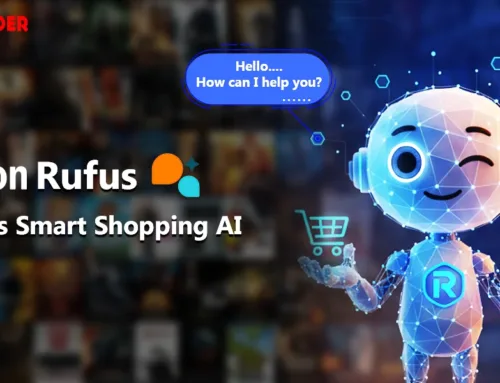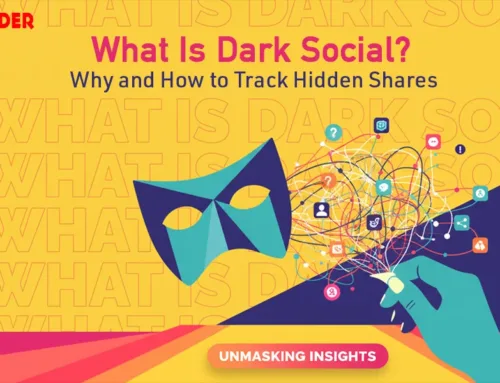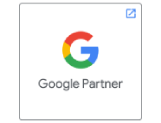We all want the content to rank higher. The better you rank, the more website organic traffic you get. But! Hundreds or even thousands of business websites compete against each other for the same content topic.
Creating high-quality content is crucial for your brand marketing strategy. But even the best content won’t drive quality organic traffic until you have a top-notch content optimization strategy. In short, Content optimization is the difference between being on the front page and being on the back page.
In this in-depth content optimization blog, we’ll discuss important questions you need to know to improve your content reach, such as how to create SEO-optimized content and what strategies can help you attract and convert website visitors.
Let’s dive in.
What Is Content Optimization?
Content optimization is refining content to make it relevant & appealing to humans and easy for search engines to understand and categorize. It is the process of ensuring your content reaches the largest possible target audience.
“Content without optimization is like a ship without a compass; it may be beautiful, but it won’t reach its destination.” – Brian Clark.
Content optimization can include search engine optimization (SEO), copy improvements, user experience changes, SEO link building, and technical fixes. When done right, content optimization can help your page rank for more keywords, hold attention longer, and convert more visitors into leads.
Why Do You Need A Content Optimization Strategy?
A content optimization strategy consists of the techniques to create SEO-optimized content. 68% of online experiences begin with a search query. This is due to Google search being the most trusted and high-quality source of traffic on the web, according to Intergrowth-SEO-Statistics.

A content optimization strategy can attract highly relevant visitors interested in your product or service.
How Does Content Optimization Impact Search Engine Rankings?
The idea behind content optimization strategy is to create content around topics and keywords your target audience is searching for to rank higher in Google search results. Because the higher you rank in Google’s SERP, the more traffic your website will get.
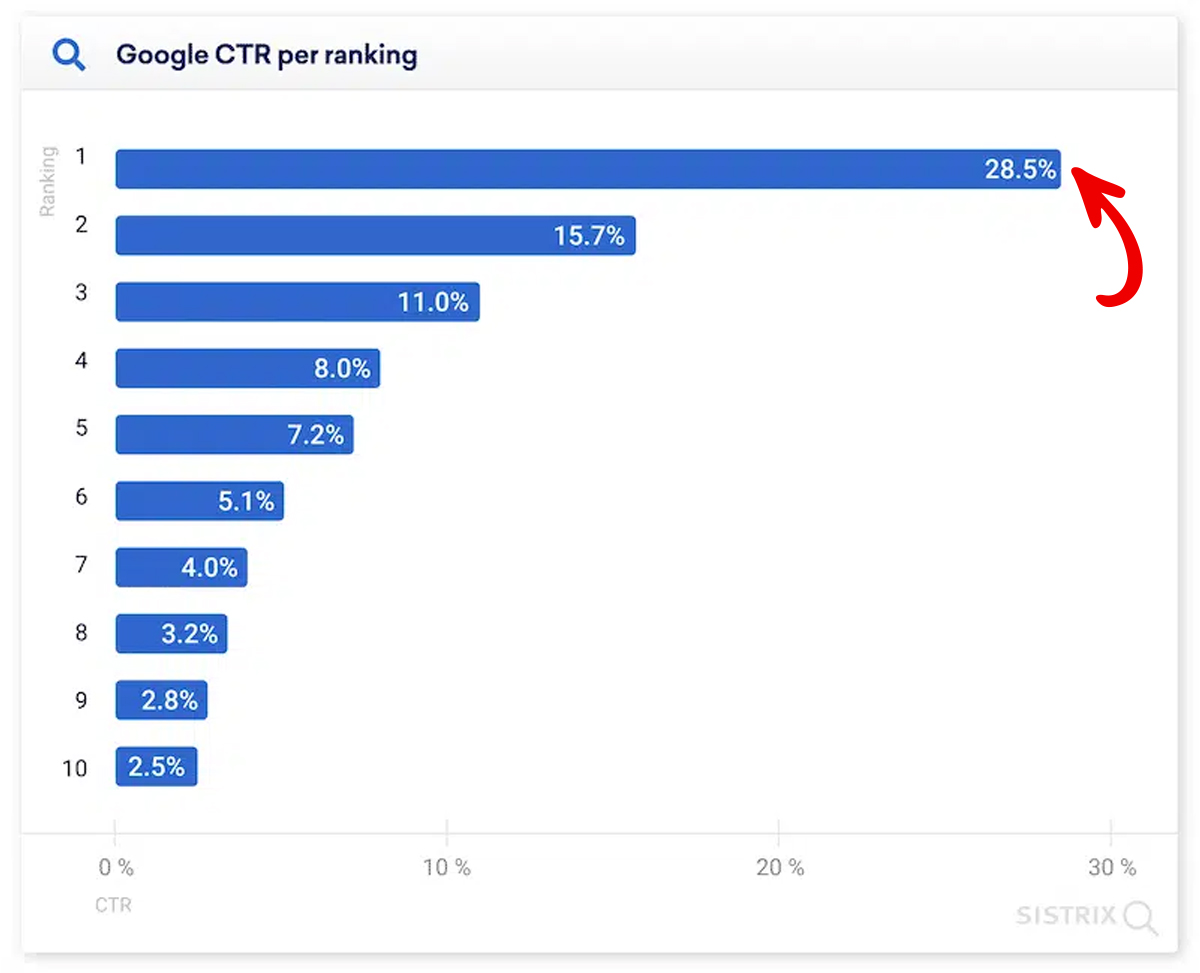
Research indicates that 75% of searchers never go past the 1st page in search engine results. Moreover, the top-ranking results on SERP page 1 get more than 28% of the total clicks. Therefore, implementing a content optimization strategy is crucial for improving your website’s visibility and attracting organic traffic.
12 Proven Content Optimization Strategy To Maximize Your Content Reach
Now that you know what content optimization is all about, let’s take a closer look at some of the most effective content optimization & SEO tactics you can use.
1— Perform Keyword Research
Keyword Research is the cornerstone of your content optimization plan. Keyword research is about finding high-quality and relevant keywords for your content creation.
To cover your topic in-depth and build your website’s search power in your industry, you must find keywords for every stage of your content marketing journey.
TOFU (top of the funnel) stage:
Find navigational and informational keywords for this TOFU stage that describe your problem & drive relevant traffic to your site. Here are some examples of navigational and informational keywords for the TOFU stage that can drive traffic to your site:

These examples help you target users in the initial stages of their research process and look for information or potential solutions related to your offerings.
Using these keywords as part of your content marketing plan will bring relevant visitors to your website and position your brand as an authority in your industry.
MOFU (middle of the funnel) stage:
At the middle of the funnel (MOFU) stage, users typically consider various products to solve their problems but have yet to decide. Find commercial keywords for this MOFU stage that target users exploring different products to solve their problems. Here are some examples of commercial keywords that target users in this stage:

These keywords target users actively researching and comparing different products, making them more likely to convert into customers if they find the information they want.
BOFU (bottom of the funnel) stage:
Users are typically ready to purchase at the bottom of the funnel (BOFU) stage. Find transactional keywords for this BOFU stage that target users interested in buying your product. Here are some examples of transactional keywords that target users interested in buying your product:
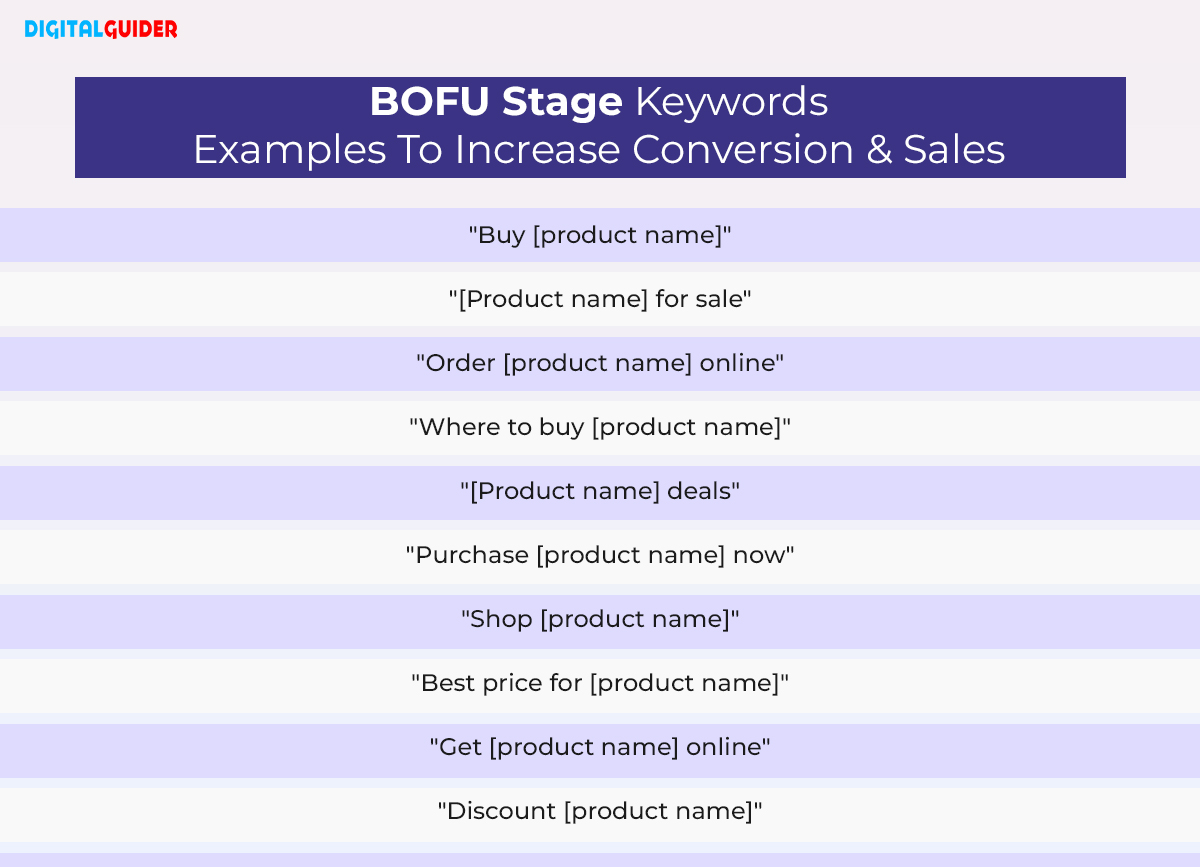
These keywords are action-oriented and indicate the user is ready to convert into a customer.
FURTHER READING:
2— Create Topic Clusters For Better Categorization
Once you’ve identified the right keywords for each stage of your content funnel, it’s time to break them down into topical groups. A topical group is a closed subset of keywords that tell the same story from different perspectives.
These LSI keywords link to a common hub page (aka. pillar content) that covers the core topic in complete detail.
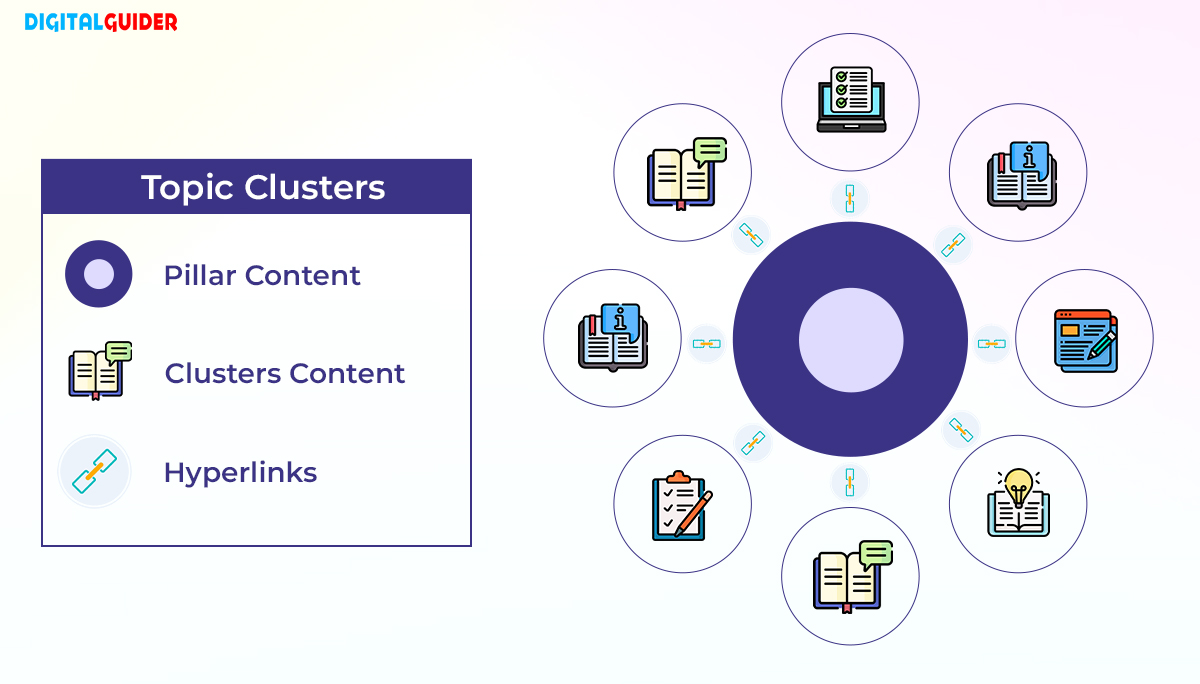
For example, if your Topic Cluster is “Home Gardening,”. The Pillar Page could be “The Complete Home Gardening Guide.” The “Keyword Pages” for this hub page could be:
- Garden Layouts: Designing Your Space
- Common Gardening Mistakes
- Beginner Gardening Tips
- Top Vegetables to Grow
- Garden Pest Control
Creating topical clusters allows you to build niche authority & rank higher for your target keywords.
3— Develop Content Benchmarks
Now that you know your target keywords, creating content benchmarks by analyzing your competitors is time. Using content benchmarks, you can ascertain your content’s length, quality, type, nature, and search intent.
Search for target keywords & open the top 10 ranking pages in separate tabs to create content benchmarks. See the content benchmarks example below, how we are creating benchmarks for the target keyword “restaurant SEO”:
Target Keyword: Restaurant SEO
Content Benchmarks:
- Word Count: Average top-ranking pages have 1,500 words.
- Target Word Count: 2,500-3,000 words
- Images and Videos: Top-ranking pages typically include 8 images and 2 videos.
- Target: 15-20 images and 3-4 videos
- Total Internal and External Links: Top-ranking pages have an average of 12 internal and 8 external links. Try to perform cross-linking the better way.
- Target: 15-20 internal links and 8-10 external links
- Keyword Usage: The primary keyword should appear in the content 5-7 times and in headlines at least once.
- Keyword Variations: Include variations like “SEO for restaurants,” “restaurant marketing strategies,” etc.
- Content-Type: (list post, guide, tutorial, comprehensive guide, buying guide, informational, comparison, etc.)
- Search Intent: Helps restaurant owners optimize their online presence to attract more customers by providing actionable SEO tips, strategies, and best practices tailored for the restaurant industry.
Similarly, use the search intent, content type, and keyword variations & follow the benchmark for other content elements to guide your content writing process.
Also Read: What Is Google E-E-A-T In SEO? Guidelines You Must Follow
4— Optimize Page Title, URL, and Headlines
On-page SEO begins with optimizing the page title, URL, and headlines. To help you understand, we’re using the education industry’s growth as an example. Here’s how to do it.
Page Title:
Use the target keyword early in the title. Let’s see the example below:
Original: “Strategies for Education Industry Growth”
Optimized: “Proven Growth Strategies for Education Industry You Must Know”
Page URL:
Use a short (2 to 3 words) URL with the target keyword. Let’s see the example below:
Original: www.yourwebsite.com/education-industry-strategies
Optimized: www.yourwebsite.com/education-industry-growth-strategies
Header Tags:
Use your target keyword and its variations in H1 (once), H2 (at least twice), H3 tags (at least once) & so on. Let’s see the example below:
<H1> 5 Proven Higher Education Marketing Strategies
<H2> What does Higher Education Marketing Mean?
<H2> Higher Education Marketing Strategies You Shouldn’t Miss
- <H3> 1. Create a Digitally Friendly Brand
- <H4> Establishing a Strong Online Presence
- <H4> Enhancing Brand Visibility in the Digital Space
- <H3> 2. Develop a Solid Content Creation Strategy
- <H4> Crafting Engaging and Relevant Content
- <H4> Tailoring Content to Target Audience Needs
- <H3> 3. Up Your Email Marketing Game
- <H4> Improving Email Campaigns for Higher Engagement
- <H4> Personalizing Email Content and Offers
- <H3> 4. Social Media Marketing
- <H4> Leveraging Social Media Platforms Effectively
- <H4> Building an Engaged Community of Followers
- <H3> 5. Create A Mobile-Friendly Website
- <H4> Ensuring Seamless User Experience Across Devices
- <H4> Optimizing Website Performance for Mobile Users
- <H3> To Sum Up
As you can see in the above example, header tags appear in the form of H1, H2, H3 & H4. This not only helps users & search engines to understand the content better.
Must Read: How Scannable Content Rules the Internet? [A Beginners Guide]
5— Optimize for Readability
If users spend valuable time reading your content, ensure it’s a great experience. There are many ways to enhance your writing:
- Write in an engaging & user-friendly tone.
- Use a spellchecker to eliminate errors.
- Use short sentences and write as you speak.
- Eliminate fluff like cliches and words like “that.”
- Vary sentence length, so your content isn’t monotonous.
Use editing tools like Hemingway, Grammarly, and Writer to improve your content’s readability.
6— Optimize Page Meta Description
Optimizing page metadata is crucial in content optimization. The meta description convinces the searcher to click on the page in Google’s search results.
So, write a compelling description that captivates the searcher and keeps them engaged with your content. When optimizing for SEO, keep the bad and good meta-description elements mentioned below in mind.
| Aspect | Bad Meta Description | Good Meta Description |
| Length | Too short, not utilizing the maximum character limit (usually 150-160 characters) | Optimal length, utilizing the full character limit to provide relevant information |
| Uniqueness | Similar to other meta descriptions, lacks uniqueness | Unique and enticing, stands out from other search results |
| Relevance | Generic and not specific to the page content | Tailored to the page content, accurately reflecting what users will find |
| Keyword Usage | Doesn’t include target keywords or variations | Includes target keywords naturally, enhancing relevance and visibility |
| Call-to-action | Lacking clear CTAs that don’t encourage users to click | Includes compelling CTAs that motivate users to click through |
7— Optimize Image & Multimedia Content
Images improve the accessibility, attractiveness, and user engagement of your content and play an important role in search engine optimization (SEO).
Image, video, and other types of multimedia content play an important role in increasing the engagement and retention of your website’s readers.

Creating and distributing excellent images in the proper format, size, and resolution is known as image optimization, and it is done to boost user interaction. See, in the case of responsive design, how crucial it is to optimize the video & image content.

GIF Source: GTmetrix
It also involves accurately labeling images with alt tags so search engine crawlers can read and understand page context. Try to use multiple images, screenshots, take ideas from the AI image generator, and use at least one relevant video when creating content. Optimize your images and screenshots using your target keyword as the alt text.
Must Read: Reverse Video Search– 6 Different Methods To Find Relevant Video Information
8— Use “People Also Ask” to Drive Traffic
In Google’s search results, most keywords have a “People also ask” section. This section lists your audience’s most frequently asked questions about your content topic and gives you valuable responses to what your audience wants to know.

Check out this section for your keyword. Use 4 to 5 questions in your content as a headline H2 or H3.
Also Read: Why use Google’s ‘People Also Search For’ for Better SEO?
9— Better Content Formatting
It is crucial to format your content effectively to ensure readers can easily consume it. Below are some guidelines on how you can structure your pages:
- – Write in a conversational tone.
- – Use short paragraphs that are only one to two lines long.
- – Organize your content using headings and subheadings.
- – Incorporate images, screenshots, and other visuals where appropriate.
- – Utilize bullet lists when necessary.
- – Use bold, italics, and underlines to emphasize important text.
10— Aim for Featured Snippets
A featured snippet is a section of the Google search results page that provides a quick response to a user’s query without requiring them to click on a link. That can show up as a table with dropdowns, a paragraph or quote, or a list with numbers or bullets. See how we can see the quick result as Google knowledge graph with the images through the Backlinko featured snippet.
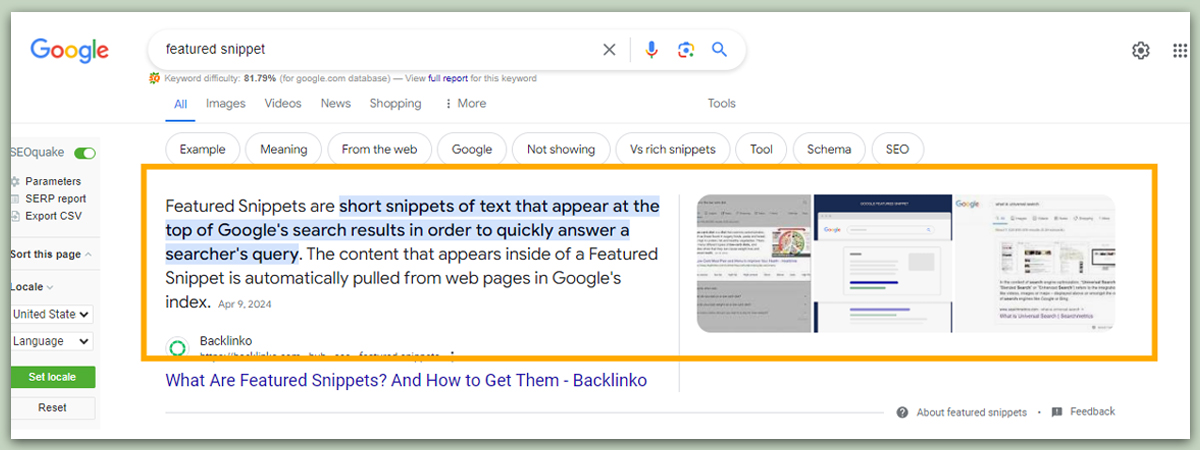
When your content appears in a featured snippet, you promote yourself as the best solution and resource for that query. By ensuring your content is in the formats featured in the snippets, you increase your chances of being chosen by search engines.
Also Read: How Google Uses NLP To Improve SERPs, Featured Snippets & UX
11— Perform Periodical Content Audits
An audit and analysis of your content can help you set a benchmark for where your content is today. You want to optimize your new content as it’s created, but there’s a good chance you’ve got older content that isn’t up to date.
By periodically analyzing the keywords, length, quality, and goals of your older content, you can create a plan to improve older content on your site.
12— Outsource if Necessary
SEO and content optimization are essential for brands that want to grow and improve their audience reach. However, staying on top of content optimization with a small team or a team with many other focuses can be hard. Outsourcing your content marketers and SEO experts can help you stay on top without doing it all yourself.
Wrap Up
Content optimization is crucial for any brand that wants to enhance its content quality and search engine optimization (SEO). If you don’t, you risk ranking lower and lower in search engine results. As you’ve seen in this blog, creating a content optimization strategy isn’t rocket science.
However, it requires deeply understanding your audience’s needs, intent, and keyword research techniques. You must create high-quality content that responds to your audience’s questions more deeply than your competitors. While content optimization can help you enhance your brand’s SERP ranking, many other aspects of a well-rounded SEO strategy require your attention.
Get started today with Digital Guider Experts Now!


